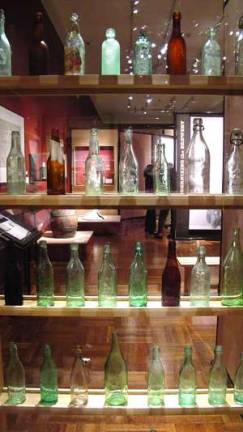A Return to When Beer Really Was Here

By Robin Elisabeth Kilmer The proprietors of the Lion's Head Tavern were not aware that a brewery once occupied the same spot where beer currently flows from their taps. Nor did they know they were paying homage to it when they chose their name 10 years ago. The Lion's Head Tavern, like everything else on the blocks from 107th to 109th Street, between Amsterdam and Central Park West, was preceded by the Lion Brewery. "I'm happy the coincidence exists," said Gus Hookanson, one of the owners of the Tavern, which was named in honor of the now-closed Lion's Head Bar in Greenwich Village. It is also a nod to Columbia University's mascot. The Lion Brewery was founded in 1857 by two German immigrants. Breweries had been flourishing in the city since the colonial era, and several opened in Brooklyn around the same time, including Rheingold, Schaefer and Piels. The Lion Brewery was demolished in 1944 and subsequently forgotten, like much of New York's brewing history. The New York Historical Society's Beer Here exhibit reminds New Yorkers of their city's hoppy heritage, shining a light on an era in which beer gardens, taverns and pubs selling locally brewed beer were as plentiful as Starbuckses are now. In the exhibit, colonial recipes for pea pod and spruce beer mingle with liquor licenses issued by Richard Varick. A few paces away is a turn-of-the-century hops press that was graffitied by bored workers. The exhibit, which features a bar, culminates with the last chapter of New York City's brewing history, in which Rheingold, Schaefer and Piels, all having survived prohibition by selling non-alcoholic beverages, reigned as the last of New York's breweries. Aggressive ad campaigns and marketing kept them alive and operating in Brooklyn until the 1970s, when the beers were sold to national conglomerates. Though the campaigns could not save the breweries, they helped the beers remain imprinted in the collective memories of a generation of New Yorkers. Naomi Hample, 75, a longtime resident of the Upper West Side, never tasted any of the local beers but remembered the Miss Rheingold girls. In what was known as the second most important election in the nation, beer drinkers cast ballots to determine who would be the face of the brewery. Every year, the city would be adorned with posters of the contestants' visages. "They would have been a little older than me at the time. They were attractive and clean-cut," Hample recalled. "We would always debate about which one was the prettiest." Though the Rheingold, Schaefer and Piels labels still exist, they are hard to find in the city of their origin. Out of several Upper West Side bars recently surveyed, just one, The Ding Dong Lounge on Columbus Avenue between 105th and 106th streets, still carries Schaefer. Ben Hudson, marketing director for Brooklyn Brewery, predicts that in the near future, small breweries will have a 15 percent share in the national market. "The only reason craft beer is thriving is because of a direct effort to connect with the community," Hudson said. Brooklyn Brewery is a sponsor of the Beer Here exhibit as well as other local endeavors. New York City has started a new chapter in its beer history. Brooklyn is home again to several breweries. The revival is reminiscent of the small-scale, heterogeneous brewing community that had once been so prevalent. "The purpose of the Brooklyn Brewery has been to bring brewing back to New York City," Hudson said. Though Brooklyn Brewery's first location was in Albany, the company brought a brewery to Brooklyn in 1996. Beer is indeed here again. "It's not a fad or trend-it's a return to normalcy," Hudson said. [gallery columns="4"]